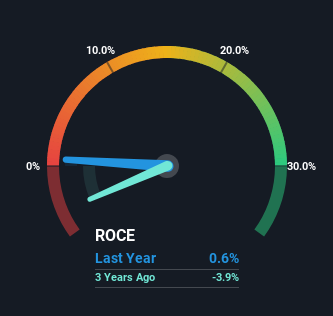- Hong Kong
- /
- Trade Distributors
- /
- SEHK:2326
New Provenance Everlasting Holdings (HKG:2326) Will Be Hoping To Turn Its Returns On Capital Around

Ignoring the stock price of a company, what are the underlying trends that tell us a business is past the growth phase? Typically, we'll see the trend of both return on capital employed (ROCE) declining and this usually coincides with a decreasing amount of capital employed. This reveals that the company isn't compounding shareholder wealth because returns are falling and its net asset base is shrinking. On that note, looking into New Provenance Everlasting Holdings (HKG:2326), we weren't too upbeat about how things were going.
What Is Return On Capital Employed (ROCE)?
If you haven't worked with ROCE before, it measures the 'return' (pre-tax profit) a company generates from capital employed in its business. The formula for this calculation on New Provenance Everlasting Holdings is:
Return on Capital Employed = Earnings Before Interest and Tax (EBIT) ÷ (Total Assets - Current Liabilities)
0.006 = HK$2.9m ÷ (HK$1.8b - HK$1.3b) (Based on the trailing twelve months to March 2023).
So, New Provenance Everlasting Holdings has an ROCE of 0.6%. In absolute terms, that's a low return and it also under-performs the Trade Distributors industry average of 4.4%.
View our latest analysis for New Provenance Everlasting Holdings

Historical performance is a great place to start when researching a stock so above you can see the gauge for New Provenance Everlasting Holdings' ROCE against it's prior returns. If you're interested in investigating New Provenance Everlasting Holdings' past further, check out this free graph of past earnings, revenue and cash flow.
What The Trend Of ROCE Can Tell Us
We are a bit anxious about the trends of ROCE at New Provenance Everlasting Holdings. The company used to generate 34% on its capital five years ago but it has since fallen noticeably. On top of that, the business is utilizing 27% less capital within its operations. The fact that both are shrinking is an indication that the business is going through some tough times. Typically businesses that exhibit these characteristics aren't the ones that tend to multiply over the long term, because statistically speaking, they've already gone through the growth phase of their life cycle.
On a separate but related note, it's important to know that New Provenance Everlasting Holdings has a current liabilities to total assets ratio of 73%, which we'd consider pretty high. This effectively means that suppliers (or short-term creditors) are funding a large portion of the business, so just be aware that this can introduce some elements of risk. Ideally we'd like to see this reduce as that would mean fewer obligations bearing risks.
In Conclusion...
To see New Provenance Everlasting Holdings reducing the capital employed in the business in tandem with diminishing returns, is concerning. We expect this has contributed to the stock plummeting 74% during the last five years. Unless there is a shift to a more positive trajectory in these metrics, we would look elsewhere.
Since virtually every company faces some risks, it's worth knowing what they are, and we've spotted 3 warning signs for New Provenance Everlasting Holdings (of which 1 makes us a bit uncomfortable!) that you should know about.
While New Provenance Everlasting Holdings may not currently earn the highest returns, we've compiled a list of companies that currently earn more than 25% return on equity. Check out this free list here.
Valuation is complex, but we're here to simplify it.
Discover if New Provenance Everlasting Holdings might be undervalued or overvalued with our detailed analysis, featuring fair value estimates, potential risks, dividends, insider trades, and its financial condition.
Access Free AnalysisHave feedback on this article? Concerned about the content? Get in touch with us directly. Alternatively, email editorial-team (at) simplywallst.com.
This article by Simply Wall St is general in nature. We provide commentary based on historical data and analyst forecasts only using an unbiased methodology and our articles are not intended to be financial advice. It does not constitute a recommendation to buy or sell any stock, and does not take account of your objectives, or your financial situation. We aim to bring you long-term focused analysis driven by fundamental data. Note that our analysis may not factor in the latest price-sensitive company announcements or qualitative material. Simply Wall St has no position in any stocks mentioned.
About SEHK:2326
New Provenance Everlasting Holdings
An investment holding company, sources and sells metal minerals and related industrial materials in Hong Kong and the People’s Republic of China.
Flawless balance sheet low.
Market Insights
Community Narratives




